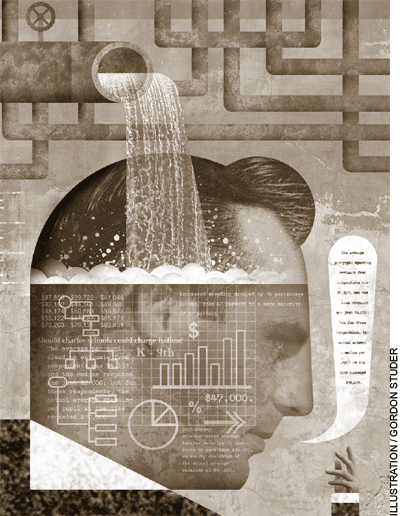 Most people express strong opinions about public education. But only a few know the basic facts about the public schools: how much they spend, how well teachers are paid, and what schools can and cannot do.
Most people express strong opinions about public education. But only a few know the basic facts about the public schools: how much they spend, how well teachers are paid, and what schools can and cannot do.
What happens when the public learns the facts about schools and deliberates responsibly about public education? Do citizens update their views on policies designed to improve public schooling? Or do they hold steadfast to their opinions, suggesting that whatever animates debate about education it is not an abiding concern about what is actually happening in our nation’s schools?
A series of experiments embedded within a national survey that we conducted in 2008 shed new light on what happens to public opinion on education when it is informed about some key facts. We divided respondents into randomly chosen groups: some were simply asked their opinion about school spending, teacher salaries, and charter schools, while others were first provided with accurate information about each of these issues. Because all that distinguished the more-informed respondents from the others is chance, we can be confident that any differences between the views of the two groups are attributable to the information provided.
The results are striking. Accurate information about what is currently being spent on public schools reduces both support for increased spending and confidence that more spending would improve student learning. Knowing how much the average teacher earns lowers support for salary increases. We observe only a modest effect of information on the views of current teachers who were surveyed and on those of respondents who are most satisfied with the performance of their local public schools. And while providing accurate information about charter schools does not change the balance of support among the public as a whole, it dramatically increases support among secular liberal respondents while undermining it among religious conservatives.
A Knowledge Deficit
It is no surprise that members of the public are eager to voice their opinions about education policy. Virtually all American adults have had direct experience with the nation’s public schools, whether as students, parents or grandparents of students, or employees. (In 2005, there were more than 6.1 million public school teachers and other district workers.) And the constantly rising cost of operating the schools, which accounts for nearly one-quarter of state and local spending nationwide, directly affects the pocketbook of every taxpayer.
Surveys nonetheless consistently reveal widespread misunderstanding of our schools and of prominent efforts to reform them. Consider the issue of school spending. Our research shows that Americans dramatically underestimate the amount spent on public schools in their districts, even when prompted to consider the full range of uses to which school spending is devoted. They also think that teachers earn, on average, far less than is actually the case. It seems that the public’s strong preference that more be spent on public education is based, at least in part, on faulty information (see “Is the Price Right?” features, Summer 2008).
Although Americans as a whole are cautiously supportive of charter schools, most reveal confusion about their basic features. For example, when we asked respondents in our 2007 survey whether charter schools are free to teach religion (they are not), or whether they can charge tuition (they cannot), almost two-thirds of the public confessed to not knowing the answer and another quarter got it wrong. Indeed, only 13 percent of adults nationwide correctly noted that charter schools cannot teach religion and 16 percent correctly observed that charter schools may not charge tuition (see “What Americans Think About Their Schools,” features, Fall 2007).
There is nothing special about education policy, of course. Multiple generations of political scientists have documented alarming rates of public ignorance about all sorts of policy issues.
The pertinent question, then, is not whether the public is ignorant about education or any other policy domain; it unmistakably is. Rather, the question is whether the sources of the public’s ignorance—inattention, confusion about the state of the world, biases and prejudices, or anything else—systematically influence the policy views that people express, and, in turn, whether these views change when facts come to the fore, as they can in responsible political deliberation.
On this last score, we think, the results from our survey experiments on school spending, teacher salaries, and charter schools provide a basis for optimism. Much of the American public appears quite willing to update its views in light of new information about public schools.
Public School Spending
A solid majority of the public supports increased funding for public schools. More than 60 percent of respondents we surveyed in 2007 believed that spending should “greatly increase” or “increase,” 32 percent said that spending should “stay about the same,” and less than 10 percent suggested it ought to decrease. As might be expected, support for higher spending was especially strong among public school teachers.
Americans, though, vastly underestimate the amount of money spent on public schools. The average per-pupil spending estimate from respondents was $4,231, and the median response was just $2,000; but for these respondents, local average spending per pupil at the time exceeded $10,000.
To investigate the relationship between information and attitudes on school spending, we conducted a simple experiment in our 2008 survey. Half the sample was asked, “Do you think that government funding for public schools in your district should increase, decrease, or stay about the same?” The other half of the sample, randomly chosen, was first informed of the average per-pupil expenditure in their school district before being asked the same question. (See the methodological sidebar for details on how respondents were matched to districts.)
Methodology
This survey, sponsored by Education Next and the Program on Education Policy and Governance (PEPG) at Harvard University, was conducted by the polling firm Knowledge Networks (KN) between February 16 and March 15, 2008. KN maintains a nationally representative panel of adults, obtained via list-assisted random digit dialing sampling techniques, who agree to participate in a limited number of online surveys. Because KN offers members of its panel free Internet access and a WebTV device that connects to a telephone and television, the sample is not limited to current computer owners or users with Internet access. When recruiting for the panel, KN sends out an advance mailing and follows up with at least 15 dial attempts. The panel, then, is updated quarterly. Detailed information about the maintenance of the KN panel, the protocols used to administer surveys, and the comparability of online and telephone surveys is available here.
The findings from the 2008 Education Next–PEPG survey reported in this essay are based on a nationally representative stratified sample of 2,500 adults (age 18 years and older) and an oversample of 700 public school teachers (see “The 2008 Education Next–PEPG Survey of Public Opinion,” features, Fall 2008). The sample consists of 2,546 non-Hispanic whites, 250 non-Hispanic blacks, and 239 Hispanics. We use poststratification population weights to adjust for survey nonresponse as well as for the oversampling of teachers. These weights ensure that the observed demographic characteristics of the final sample match the known characteristics of the national adult population.
To conduct the spending experiment, we matched survey respondents to school districts using either census blocks or zip codes. When we relied on zip codes, we could not match some respondents to a unique school district. For such respondents we calculated the average per-pupil spending levels for each district that served the relevant zip code, weighted by districts’ population sizes.
Teacher salary data, by contrast, are available only at the state level. We were able to match all survey respondents to the states in which they resided. Data on per-pupil spending come from the National Center for Education Statistics Common Core of Data, “Local Education Agency Finance Survey.” Data on teacher salaries come from the American Federation of Teachers publication “Survey and Analysis of Teacher Salary Trends 2005.” Both sources cover the 2004–05 academic year, the latest for which this information is available.
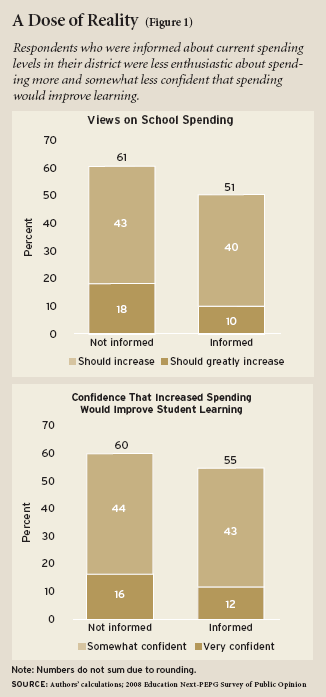 When told how much the local schools were spending, respondents tempered their enthusiasm for spending increases. For the public as a whole, support for increased spending dropped by 10 percentage points, from 61 percent to a bare majority of 51 percent (see Figure 1). This difference is statistically significant, as are the differences discussed below.
When told how much the local schools were spending, respondents tempered their enthusiasm for spending increases. For the public as a whole, support for increased spending dropped by 10 percentage points, from 61 percent to a bare majority of 51 percent (see Figure 1). This difference is statistically significant, as are the differences discussed below.
The effect of accurate information carried over into respondents’ professed confidence that increased spending would improve student learning, although the change was more modest in size. Sixty percent of the public not provided with new information claimed to be either “very confident” or “confident” that more spending would improve student learning, compared to 55 percent of respondents who were told how much is spent on their local schools. Similarly, the share of respondents in the two groups who were “very confident” in the benefits of increased spending was 16 and 12 percent, respectively.
These differences are consistent across a wide range of subgroups, as defined by socioeconomic backgrounds, views about the local public schools, and political ideologies. Interestingly, differences also appear among teachers, whom one might think already have deeply entrenched and well-informed views about public education. Whereas 35 percent of teachers not specifically informed of spending levels claimed that spending should “greatly increase,” only 22 percent of those who were told the amount of money spent to educate a child in their district thought so. Additionally, 29 percent of teachers in the first group expressed strong confidence that increased spending would boost student learning, compared to 20 percent of those who were provided with information on current spending.
Even so, half of Americans—and much larger shares of ethnic minorities and teachers—continued to believe that spending on their local public schools should increase, even when given accurate information on current spending levels. Only 1 in 10 respondents reported that spending should decrease.
Teacher Salaries
The bulk of the American public also supports increasing teacher salaries. As with per-pupil expenditures, the public significantly underestimates how much the governments in their states pay public school teachers. On average, respondents in our 2007 survey underestimated average teacher salaries in their state by more than $14,000, or nearly one-third of the actual average salaries of $47,000.
We conducted an experiment in 2008 on teacher salaries, similar to that on spending, in which half the sample was asked directly, “Do you think that teacher salaries in your state should increase, decrease, or stay about the same?” and the other half was first informed about the average teacher salaries in their state. (Again, see the sidebar for details on our data sources and methods.)
When asked directly, 69 percent of the public supported increasing teacher salaries, 28 percent thought they should stay about the same, and just 4 percent believed that they should be decreased. Looking across various subgroups of the population, African Americans and teachers appeared most enthusiastic about increasing teacher salaries, with roughly 9 out of 10 endorsing a salary increase. Whites, meanwhile, were most skeptical.
Responses again diverged from this pattern when information was provided (see Figure 2). Among the public as a whole, information about actual teacher salaries depressed support for salary increases by fully 14 percentage points. Notably, the percentage of people who advocated for salary cuts remained constant, with those preferring that salaries stay about the same picking up the remainder.
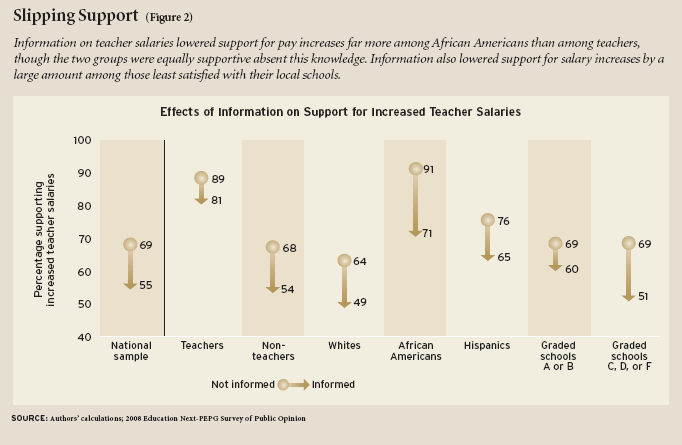
The two most enthusiastic groups of supporters of increasing teacher salaries, however, responded very differently from one another to the experiment. Support for increasing salaries dropped by 20 percentage points (from 91 to 71 percent) among African Americans who were told about actual teacher salaries. The larger effects among African Americans do not appear to reflect differences in income, as the effects are equally pronounced among those African Americans in households earning more than $50,000 annually. Support among teachers, meanwhile, dropped by just 8 percentage points.
What should we make of the fact that teachers substantially downgrade their assessments of the need for higher per-pupil expenditures, but not for higher salaries, when they are exposed to basic facts about actual spending? One might theorize that teachers are already well informed about actual salaries, and hence they have no need to update their views when presented with facts. This, however, does not appear to be the case: teachers underestimated, on average, teacher salaries in their state by almost $9,500 (or 20 percent of actual salaries), making them only modestly more accurate in their assessments than the public as a whole.
Self-interest appears the more likely explanation for the relatively small effect of information on teachers. Told that teachers in their state earn more on average than they thought, the teachers’ appetite for still higher salaries is hardly abated.
The effect of information also varied according to respondents’ degree of satisfaction with their local public schools. Among those who earlier in the same survey assigned the schools in their community a grade of A or B, the provision of information on actual teacher salaries reduced support by just 9 percentage points, from 69 percent to 60 percent. Among respondents who assigned their schools a grade of C or lower, information reduced support by a whopping 18 percentage points. Again, these differences in treatment effects do not simply reflect differences in the accuracy of prior knowledge. Respondents assigning lower grades to local schools were no less accurate in their initial estimates of teacher salaries than the national population.
Charter Schools
A plurality of the public as a whole supports charter schools, with 16 percent expressing “complete” support and another 26 percent saying that they support them “somewhat.” Indeed, supporters of charter schools outnumber opponents by more than two to one. The most common response, however, is “neither support nor oppose.” Roughly 40 percent of the American public remains undecided about the merits of this breed of public school.
This pattern of lukewarm support reflects the views of respondents presented with the following description of charter schools: “Many states permit the formation of charter schools, which are publicly funded but are not managed by the local school board. These schools are expected to meet promised objectives, but are exempt from many state regulations.”
As noted above, however, our 2007 survey revealed widespread confusion about charter schools. For example, less than 1 in 10 respondents knew that charter schools may neither charge tuition nor provide religious instruction. To investigate the effect of such uncertainties and misperceptions about charter schools on the public’s willingness to endorse them, we informed a randomly chosen group of respondents that charter schools “cannot charge tuition and they cannot provide religious instruction” before probing their support.
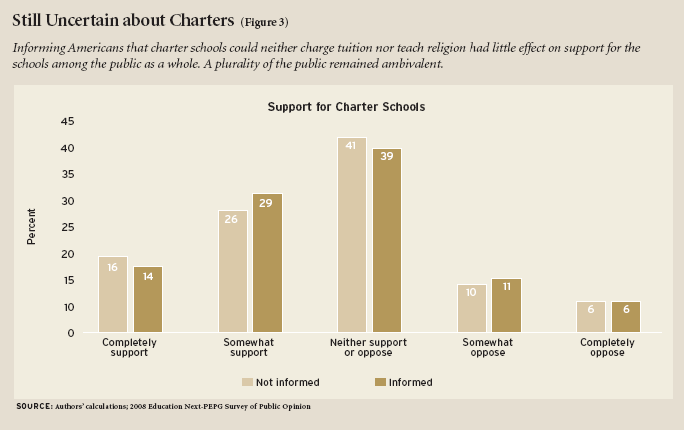
The responses of the public as a whole were scarcely affected by this additional information (see Figure 3). The picture changes dramatically when we group the population according to self-identified political ideology (see Figure 4). Forty-nine percent of conservatives and 36 percent of liberals who were not provided information supported charter schools. But when they were told that charter schools are tuition-free and secular, support dropped among conservatives by 6 percentage points and increased among liberals by 11 percentage points. Indeed, when provided information, liberals were 4 percentage points more likely to support charter schools than were conservatives.
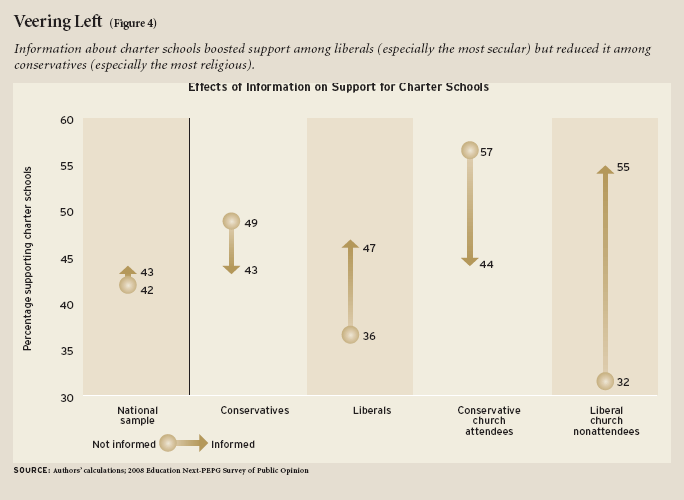
What explains this shift? A closer look at the data suggests that the key factor may be religion. Among self-identified conservatives who attend church at least once a week, support for charter schools was 13 percentage points lower for those provided with information. Conversely, support among liberals who never attend church increased by a whopping 23 percentage points, from 32 to 55 percent.
In a final wrinkle in the experiment, we provided another randomly chosen group of respondents with one additional piece of information about charter schools: that they “cannot choose among students who apply.” This information did not shift attitudes one way or another relative to the views expressed by those informed only about tuition and religion. This was true for the public as a whole as well as for the groups that had been most sensitive to the information about tuition and religion.
Conclusion
Our investigation of the effects of information on public support for school spending and charter schools yields strikingly different patterns.
Information on per-pupil expenditures tempered the public’s enthusiasm for increased spending, both among survey respondents as a whole and across a wide array of subgroups. At the time this experiment was conducted (early in 2008), a slight majority continued to support increased spending. We do not know whether, in the current economic crisis, information about actual expenditures might further depress support for spending hikes.
Information about actual teacher salaries also tended to depress support for salary increases, a finding that may complicate recent proposals to provide the public with accurate information about compensation packages as a strategy to enhance teacher recruitment. The fact that the public thinks teachers earn so much less than they actually do surely makes it more difficult to attract talented candidates into the profession. But our results suggest that efforts to publicize the truth about teacher salaries would also make it substantially harder to build support for further salary increases.
It is hardly surprising that the effects of information about salaries were quite modest among teachers, who have a personal stake in better pay. Yet the fact that information had especially large and negative effects on support for increased teacher salaries among African Americans and those least satisfied with their local public schools may hold important implications for the politics of education in the large urban districts where these groups are most concentrated. An urban superintendent seeking to reform teacher compensation might well increase support among the district’s constituents by ensuring that they have accurate information about what teachers currently earn.
When some key areas of confusion about charter schools are cleared up, overall public support for charter schools appears unaffected. This null finding, however, masks huge effects within certain groups. More information led to lower levels of support among conservatives, especially the more religiously devout, but raised support among secular liberals.
These last findings suggest that information, rather than facilitating compromise and consensus, can actually polarize debate. They also portend a major shift in the political landscape of school choice. Traditionally, charter schools have been viewed as falling primarily within the province of conservatives’ preferred education reforms. Yet our results show that basic facts about the design of charter schools appeal more to liberals. It is quite possible, then, that as the public becomes more informed about these public schools, core support for them may shift from the right to the left of the political spectrum. Indeed, the recent election of a liberal (and presumably well-informed) president who professes strong support of charter schools may be a sign that this process is under way.
William G. Howell is associate professor in the Harris School of Public Policy at the University of Chicago. Martin R. West is assistant professor of education at Brown University and an executive editor of Education Next.
This article appeared in the Summer 2009 issue of Education Next. Suggested citation format:
Howell, W.G., and West, M.R. (2009). Educating the Public: How information affects Americans’ support for school spending and charter schools. Education Next, 9(3), 40-47.


